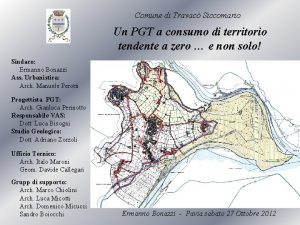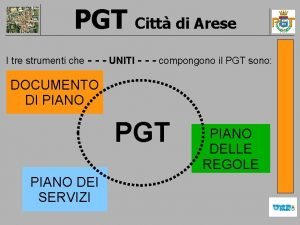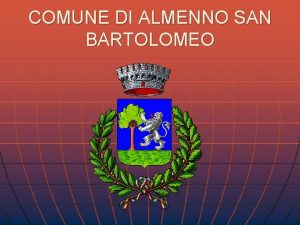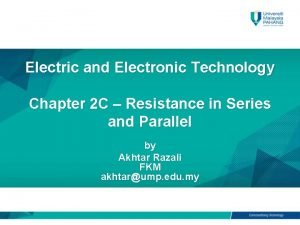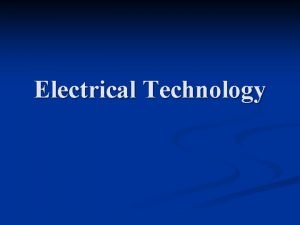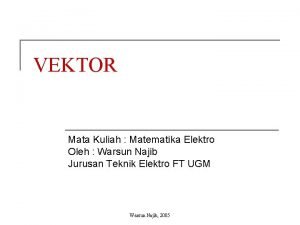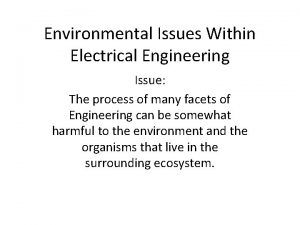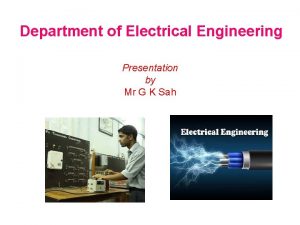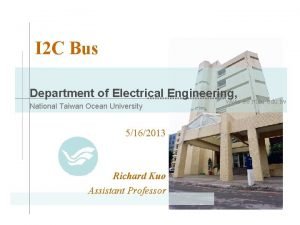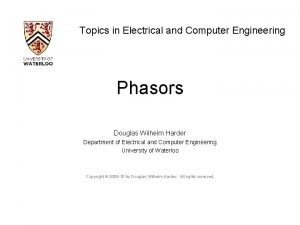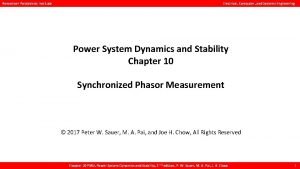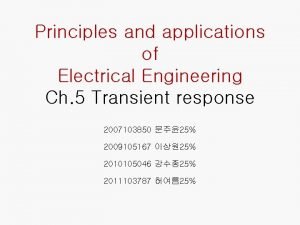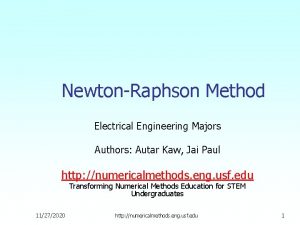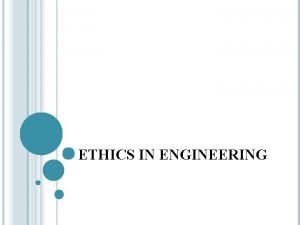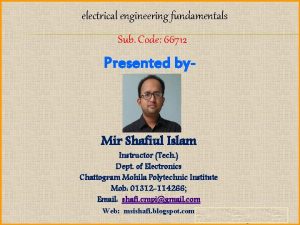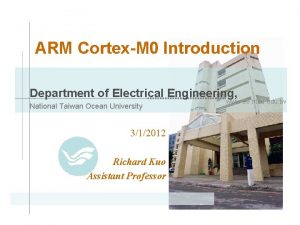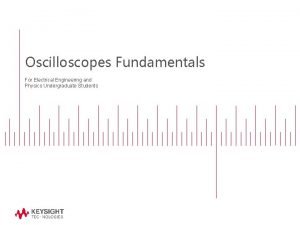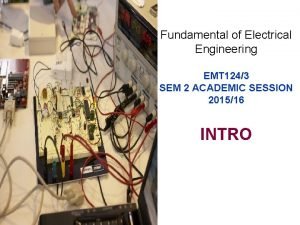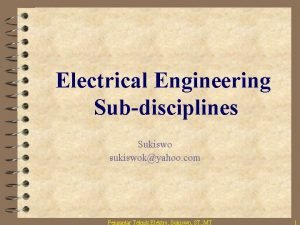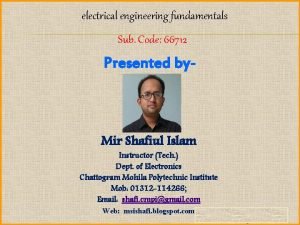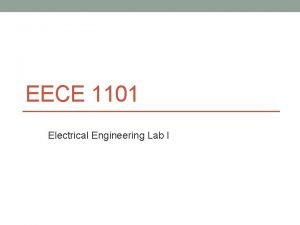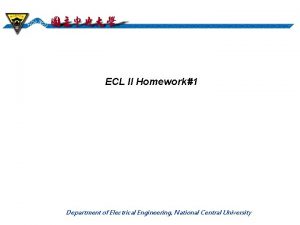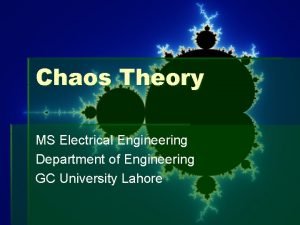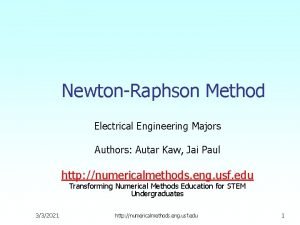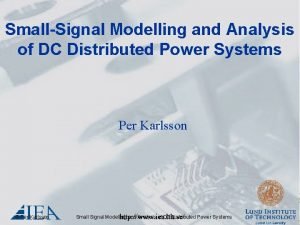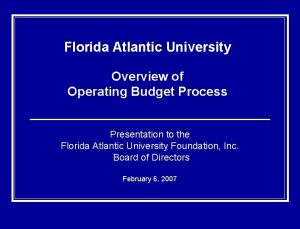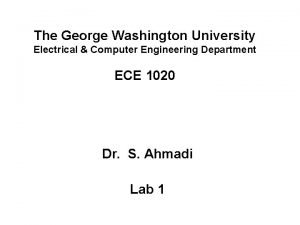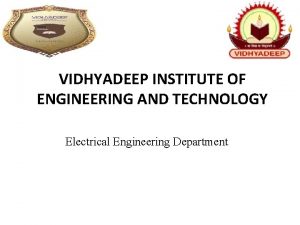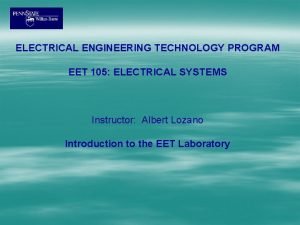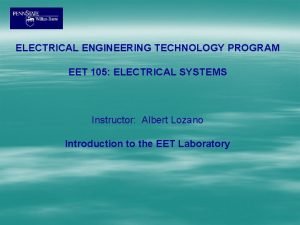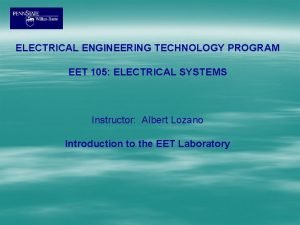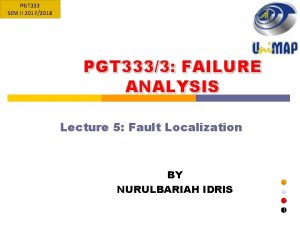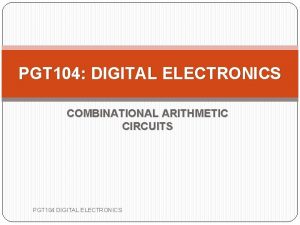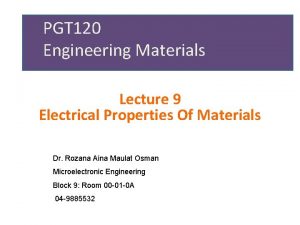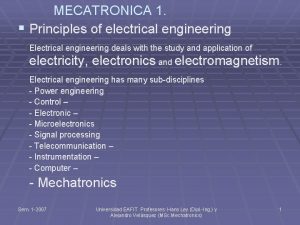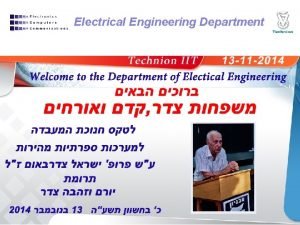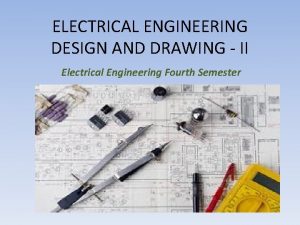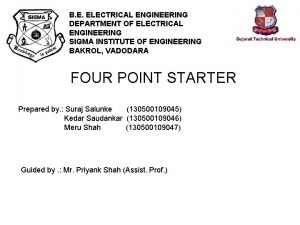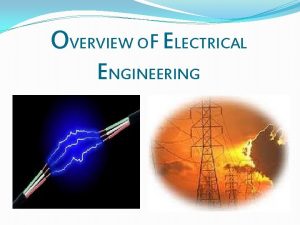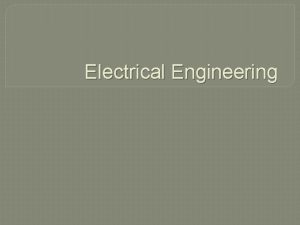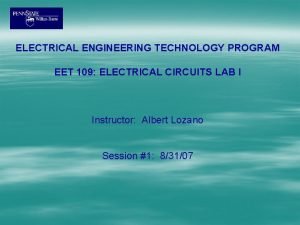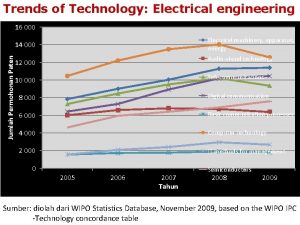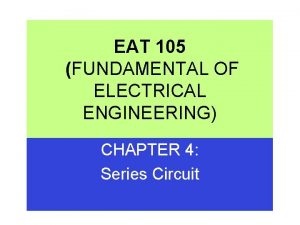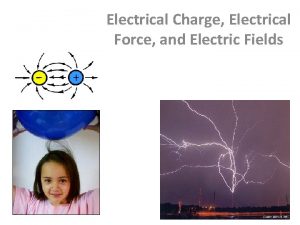PGT 105 ELECTRICAL ENGINEERING TECHNOLOGY CHAPTER 1 c

































































- Slides: 65

PGT 105 ELECTRICAL ENGINEERING TECHNOLOGY CHAPTER 1 (c) INTRODUCTION TO ELECTRICITY AND SUPPLY SYSTEM ~AC Three Phases Electric System ~ Lecturers: Mr. Khairul Affendi

Contents 1. Definition & comparison of AC Single Phase & Three Phases System. 2. Sine wave parameters: - Vrms, Vp-p, Vavg. 3. Typical connection between three phases generator and load: - Star-Wye (Y) & Delta system. 4. Comparison & Advantages of Single-Phase & Three. Phase Supply System Chapter 1(c)- AC Three Phases 2

Interest Approach • Does anyone have 3 phase current at home? • What would be an indication of 3 phase current? Chapter 1(c)- AC Three Phases 3

LESSON 1 Definition & comparison of AC Single Phase & Three Phases System. Chapter 1(c)- AC Three Phases 4

Definition & Comparison Let’s review the AC single phase system… Chapter 1(c)- AC Three Phases 5

Definition & Comparison And now, time for the AC three phase system… Chapter 1(c)- AC Three Phases 6

Definition & Comparison AC three phase system… • Three conductors carry the same single-phase sine wave power but reach their peak values at different times. • Seen that one of the other conductors is 1/3 of a cycle ahead of the reference and the other is 1/3 of a cycle behind the reference. • Got more constant power transfer over a cycle as compared to single-phase power & possible to produce a rotating magnetic field in a three-phase motor. Chapter 1(c)- AC Three Phases 7

Chapter 1(c)- AC Three Phases 8

Chapter 1(c)- AC Three Phases 9

Chapter 1(c)- AC Three Phases 10

LESSON 2 Sine wave parameters: Vp, Vp-p, Vrms, Chapter 1(c)- AC Three Phases 11

Sine Wave Parameters Let’s review the AC single phase system… Chapter 1(c)- AC Three Phases 12

Chapter 1(c)- AC Three Phases 13

Chapter 1(c)- AC Three Phases 14

LESSON 3 Comparison & Advantages of Single-Phase & Three-Phase Supply System Chapter 1(c)- AC Three Phases 15

Comparison & Advantages of Single -Phase & Three-Phase Supply System Advantage no. 1 • Three-phase current offers a steadier source of power. • Magnetic force which, causes motor rotation is strongest when current flow is at its peak in the cycle. Advantage no. 2 • The power delivered by a single-phase system pulsates and falls to zero. The three-phase power never falls to zero. The power delivered to the load in a three-phase system is the same at any instant. This produces superior operating characteristics for three-phase motors. Chapter 1(c)- AC Three Phases 16

Advantage no. 3 • Single-phase current peaks twice during one cycle, whereas, three-phase current peaks six times during one cycle. Advantage no. 4 • Three-phase motors are simpler, cheaper to buy and maintain, and safer to use around combustible materials since there is no sparking when they start. • This is because three-phase current allows a motor to be self-starting since it produces a rotating field of magnetism in the motor. • This eliminates the need for a separate starting winding, centrifugal switch, starting capacitor, or a system of brushes. • Chapter 1(c)- AC Three Phases 17

Advantage no. 5 • Three-phase motors are available in larger horsepower sizes than single-phase motors. • Current is supplied to the motor with three conductors rather than two. • This allowed the power supplied to larger threephase motors to be on the same size conductor as that required for smaller single-phase motors. Advantage no. 6 • A balanced three-phase, three-wire circuit with equal voltages uses 75% of the copper required for conductors. They supply a single phase two-wire circuit of the same capacity, voltage rating, length of circuit, and transmission efficiency. Chapter 1(c)- AC Three Phases 18

Advantage no. 7 • Three-phase motors are less expensive and usually lighter and smaller than single-phase motors of the same horsepower rating. • There is also a wider choice of enclosures available than for single-phase motors. Disadvantages • Three-phase current service is much more expensive to have than single-phase current at a local resident. • It requires more lines to be brought in and three transformers versus one transformer required for single-phase current Chapter 1(c)- AC Three Phases 19

LESSON 4 Typical connection/topology between three phases sources and load: • Star@Wye(Y) • Delta system. Chapter 1(c)- AC Three Phases 20

How are the sources connected? A three-phase system may be arranged in delta (∆) or star (Y) or wye • (a) shows the sources (phases) connected in a wye (Y). o Notice the fourth terminal, known as Neutral. • (b) shows the sources (phases) connected in a delta (∆). o Three terminals Chapter 1(c)- AC Three Phases 21

• Allows the use of two different voltages from all three phases, such as a 230/400 V system which provides 230 V between the neutral (centre hub) and any one of the phases, and 400 V across any two phases. Chapter 1(c)- AC Three Phases 22

Delta Source Vab = | Vab | 0 Vbc = Vab -120 Vca = Vab -240 • Arrangement only provides one voltage magnitude, however it has a greater redundancy as it may continue to operate normally with one of the three supply windings offline, albeit at 57. 7% of total capacity. Chapter 1(c)- AC Three Phases 23

Wye – Wye System Chapter 1(c)- AC Three Phases 24

Delta – Delta System Chapter 1(c)- AC Three Phases 25

Delta – Wye System Chapter 1(c)- AC Three Phases 26

Wye - Delta System Chapter 1(c)- AC Three Phases 27

Phase voltages are the voltages across phases. • For a Y load, phase voltage is measured from line to neutral (n) • For the 1(c)-generator, Chapter AC Three Phases EAN, EBN and ECN are the phase voltages. 28

Line voltages are the voltages between the lines A, B and C Chapter 1(c)- AC Three Phases 29

Phase/Line Voltages Line and phase voltages of the Yconnected three-phase generator. Chapter 1(c)- AC Three Phases Determining a line voltage for a three-phase generator. 30

Line/Phase Voltages for a Wye Circuit • Relationship between line and phase voltages • For a balanced Y system, the magnitude of line-to-line voltage is 1. 732 times the magnitude of the phase voltage. • Line to line voltage leads phase voltage by 30. Chapter 1(c)- AC Three Phases 31

CURRENTS Line currents are the currents in the line conductors. Phase currents are the currents through phases. For Y loads, line current and phase current are the same. Chapter 1(c)- AC Three Phases 32

Currents for a Wye Circuit • For Y loads, line current and phase current are the same. Line current Chapter 1(c)- AC Three Phases Phase current 33

Diagram of 3 -phase system Chapter 1(c)- AC Three Phases 34

Chapter 1(c)- AC Three Phases 35

Chapter 1(c)- AC Three Phases 36

Chapter 1(c)- AC Three Phases 37

Look at a Y-Y System Chapter 1(c)- AC Three Phases 38

Definitions • Zg represents the internal generator impedance per phase • Zl represents the impedance of the line connecting the generator to the load • ZA, B, C represents the load impedance per phase • Zo represents the impedance of the neutral conductor Chapter 1(c)- AC Three Phases 39

Look at the Line and Load Voltages Chapter 1(c)- AC Three Phases 40

Line Voltages Chapter 1(c)- AC Three Phases Phase Voltages 41

Vector addition to find VAB=VAN-VBN Chapter 1(c)- AC Three Phases 42

Using the Tip-to-Tail Method -VBN VΦ = Line-to-Neutral, or Phase Voltage VAB = VAN – VBN = √ 3 VΦ Chapter 1(c)- AC Three Phases 43

Notes for Wye(Y) connection • The amplitude of the line-to-line voltage is equal to √ 3 times the amplitude of the phase voltage. • The line-to-line voltages form a balanced set of 3 phase voltages. • The set of line-to-line voltages leads the set of line-to -neutral (phase) voltages by 30°. Chapter 1(c)- AC Three Phases 44

Look at the Delta-Connected Load Chapter 1(c)- AC Three Phases 45

Chapter 1(c)- AC Three Phases 46

Line Currents Chapter 1(c)- AC Three Phases Phase Currents 47

Vector Addition to find Ia. A=IAB-ICA Chapter 1(c)- AC Three Phases 48

Using the Tip-to-Tail Method -ICA Ia. A = √ 3 IΦ/-30° Chapter 1(c)- AC Three Phases 49

Notes for the Delta Connection • The amplitude of the line current is equal to √ 3 times the phase current. • The set of line currents lags the phase currents by 30°. Chapter 1(c)- AC Three Phases 50

• • • Wye Connections In a wye system, the line voltage is higher than the phase voltage by a factor of the square root of 3 (1. 732). ELine = EPhase x 1. 732 EPhase = ELine / 1. 732 In a wye system, the line current is equal to the phase current. ILine = IPhase Chapter 1(c)- AC Three Phases 51

Line and phase voltages in a wye connection. Chapter 1(c)- AC Three Phases 52

Line and phase currents in a wye connection. Chapter 1(c)- AC Three Phases 53

-connected Load For loads, phase voltage and line voltage are the same thing. Chapter 1(c)- AC Three Phases 54

load definitions Y-Y Line currents are the currents in the line conductors. Phase currents are the currents through phases. Chapter 1(c)- AC Three Phases 55

Line/Phase Currents for a Delta Circuit Line current Chapter 1(c)- AC Three Phases Phase current 56

• • • Delta Connections In a delta system, the line current is higher than the phase current by a factor of the square root of 3 (1. 732). ILine = IPhase x 1. 732 IPhase = ILine / 1. 732 In a delta system, the line current is equal to the phase current. ELine = EPhase Chapter 1(c)- AC Three Phases 57

Delta system voltage and current relationships. Chapter 1(c)- AC Three Phases 58

Delta system division of currents. Chapter 1(c)- AC Three Phases 59

Chapter 1(c)- AC Three Phases 60

Example Problem 1 EAN = 7620 -18 V What are the phase voltages EBN, and ECN? Chapter 1(c)- AC Three Phases 61

Example Problem 2 EAN = 7620 -18 V What are the line voltages ? Chapter 1(c)- AC Three Phases 62

Example Problem 3 For the load depicted below, EAN = 277 -30 V. Find the phase voltages and line voltages and currents. Sketch their phasor values. Chapter 1(c)- AC Three Phases 63

Review Questions 1. Describe the primary difference between singlephase and three-phase current. 2. Describe advantages and disadvantages of three-phase current as compared to singlephase current. 3. Explain the differences between deltaconnected, open delta-connected, and wyeconnected transformers and their resulting voltages. Chapter 1(c)- AC Three Phases 64

END OF CHAPTER 1 Chapter 1(c)- AC Three Phases 65
 Pgt travacò siccomario
Pgt travacò siccomario Pgt martinengo
Pgt martinengo Pgt arese
Pgt arese Istituto comprensivo vedano olona
Istituto comprensivo vedano olona Pgt almenno san salvatore
Pgt almenno san salvatore Pgt mandello del lario
Pgt mandello del lario Electrical technology chapter 2
Electrical technology chapter 2 Define electrical engineering
Define electrical engineering Define electrical technology
Define electrical technology Structure of power system
Structure of power system 2020 revised curriculum and assessment plans
2020 revised curriculum and assessment plans Pengurangan vektor
Pengurangan vektor George washington university electrical engineering
George washington university electrical engineering Tel aviv university electrical engineering
Tel aviv university electrical engineering Electrical engineering northwestern
Electrical engineering northwestern Klipsch school of electrical and computer engineering
Klipsch school of electrical and computer engineering Electrical engineering department
Electrical engineering department Electrical engineering umd
Electrical engineering umd House wiring estimating and costing
House wiring estimating and costing Electrical engineering environmental issues
Electrical engineering environmental issues Umassd electrical engineering flowchart
Umassd electrical engineering flowchart Electrical engineering presentation
Electrical engineering presentation Kfupm ee faculty
Kfupm ee faculty Big data in electrical engineering
Big data in electrical engineering Basic electrical engineering kulshreshtha
Basic electrical engineering kulshreshtha University of belgrade school of electrical engineering
University of belgrade school of electrical engineering Electrical engineering notation
Electrical engineering notation Bus electrical engineering
Bus electrical engineering Hello im human
Hello im human Clemson university electrical engineering
Clemson university electrical engineering Usf electrical engineering faculty
Usf electrical engineering faculty Phasors in electrical engineering
Phasors in electrical engineering Electrical engineering technion
Electrical engineering technion Kth master electrical engineering
Kth master electrical engineering Rensselaer polytechnic institute electrical engineering
Rensselaer polytechnic institute electrical engineering 고유응답
고유응답 Newton raphson method electrical engineering
Newton raphson method electrical engineering La tech electrical engineering
La tech electrical engineering Faculty of electrical engineering
Faculty of electrical engineering What are ethics in engineering
What are ethics in engineering Electrical engineering fundamentals (66712)
Electrical engineering fundamentals (66712) Uh electrical engineering flowchart
Uh electrical engineering flowchart Electrical engineering roadmap
Electrical engineering roadmap Tel aviv university electrical engineering
Tel aviv university electrical engineering Tum department of electrical and computer engineering
Tum department of electrical and computer engineering Electrical engineering
Electrical engineering Fundamental of electrical engineering
Fundamental of electrical engineering Electrical engineering has many subdisciplines
Electrical engineering has many subdisciplines Electrical engineering
Electrical engineering Electrical engineering fundamentals 66712 pdf
Electrical engineering fundamentals 66712 pdf Electrical engineering
Electrical engineering Electrical engineering
Electrical engineering Electrical engineering
Electrical engineering Electrical engineering math
Electrical engineering math Electrical engineering
Electrical engineering Ucla electrical engineering
Ucla electrical engineering Asu online electrical engineering
Asu online electrical engineering Principles and applications of electrical engineering
Principles and applications of electrical engineering Newton raphson method electrical engineering
Newton raphson method electrical engineering Electrical engineering
Electrical engineering Fau computer science flowchart
Fau computer science flowchart Principles and applications of electrical engineering
Principles and applications of electrical engineering Efe spletna ucilnica
Efe spletna ucilnica George washington university electrical engineering
George washington university electrical engineering Deguration
Deguration Vidhyadeep institute of engineering and technology
Vidhyadeep institute of engineering and technology
